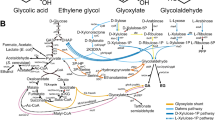Abstract
With the aim of regulating clock gene expression to control cell activities in cell processing engineering, the effect of the combination of residual glucose concentration and subsequent increment by temporal glucose feeding on the oscillation of the expression of clock gene Per2 was investigated employing rat Mesenchymal stem cell (MSC)-like cells having Per2 promoter gene with a destabilized luciferase gene (Per2-dLuc). Two experiments with several initial glucose concentrations and different times of cultures (2 and 5 days) before temporal glucose feeding (0.9 g/L) were employed to realize various concentrations of residual glucose in the medium before the feeding. In these experiments, the lower residual glucose concentrations (0.002–0.02 g/L) before temporal glucose feeding tended to induce the larger amplitude of oscillation of Per2 expression than the higher ones (0.55–0.74 g/L). When the residual glucose concentration before glucose feeding was low (0.014–0.038 g/L), the higher temporal glucose concentration (0.23–0.9 g/L) feeding tended to induce the larger amplitude of oscillation of Per2 expression than the lower ones (0.012–0.023 g/L). Taken together, we found that the amplitude of oscillation of the expression of clock gene Per2 could be controlled by the combination of residual glucose concentration and glucose concentration of subsequent temporal feeding.






Similar content being viewed by others
References
Akashi M, Nishida E (2000) Involvement of the MAP kinase cascade in resetting of the mammalian circadian clock. Gene Dev 14:645–649
Akhtar RA, Reddy AB, Maywood ES, Clayton JD, King VM, Smith AG, Gant TW, Hastings MH, Kyriacou CP (2002) Circadian cycling of the mouse liver transcriptome, as revealed by cDNA microarray, is driven by the suprachiasmatic nucleus. Curr Biol 12:540–550
Balsalobre A, Damiola F, Schibler U (1998) A serum shock induces circadian gene expression in mammalian tissue culture cells. Cell 93:929–937
Duez H, Staels B (2010) Nuclear receptors linking circadian rhythms and cardiometabolic control. Arterioscler Thromb Vasc Biol 30:1529–1534
He PJ, Hirata M, Yamauchi N, Hashimoto S, Hattori MA (2007) The disruption of circadian clockwork in differentiating cells from rat reproductive tissues as identified by in vitro real-time monitoring system. J Endocrinol 193:413–420
Hirota T, Okano T, Kokame K, Shirotani-Ikejima H, Miyata T, Fukada Y (2002) Glucose down-regulates Per1 and Per2 mRNA levels and induces circadian gene expression in cultured Rat-1 fibroblasts. J Biol Chem 277(46):44244–44251
Hirota T, Kon N, Itagaki T, Hoshina N, Okano T, Fukada Y (2010) Transcriptional repressor TIEG1 regulates Bmal1 gene through GC box and controls circadian clockwork. Genes Cells 15:111–121
Lowrey PL, Takahashi JS (2004) Mammalian circadian biology: elucidating genome-wide levels of temporal organization. Annu Rev Genomics Hum Genet 5:407–441
Matsuo T, Yamaguchi S, Mitsui S, Emi A, Shimoda F, Okamura H (2003) Control mechanism of the circadian clock for timing of cell division in vivo. Science 302:255–259
Nagoshi E, Saini C, Bauer C, Laroche T, Naef F, Schibler U (2004) Circadian gene expression in individual fibroblasts: cell-autonomous and self-sustained oscillators pass time to daughter cells. Cell 119:693–705
Nagoshi E, Brown SA, Dibner C, Kornmann B, Schibler U (2005) Circadian gene expression in cultured cells. Methods Enzymol 393:543–557
Nishide S, Hashimoto K, Nishio T, Honma K, Honma S (2014) Organ-specific development characterizes circadian clock gene Per2 expression in rats. Am J Physiol Regul Integr Comp Physiol 306:R67–R74
Panda S, Antoch M, Miller B, Su A, Schook A, Straume M, Schultz P, Kay S, Takahashi J, Hogenesch JB (2002) Coordinated transcription of key pathways in the mouse by the circadian clock. Cell 109:307–320
Putker M, Crosby P, Feeney KA, Hoyle NP, Costa ASH, Gaude E, Frezza C, O’Neill JS (2018) Mammalian circadian period, but not phase and amplitude, is robust against redox and metabolic perturbations. Antioxid Redox Signal 28:507–520
Reppert SM, Weaver DR (2002) Coordination of circadian timing in mammals. Nature 418:935–941
Storch KF, Lipan O, Leykin I, Viswanathan N, Davis FC, Wong WH, Weitz CJ (2002) Extensive and divergent circadian gene expression in liver and heart. Nature 417:78–83
Welsh DK, Yoo SH, Liu AC, Takahashi JS, Kay SA (2004) Bioluminescence imaging of individual fibroblasts reveals persistent, independently phased circadian rhythms of clock gene expression. Curr Biol 14:2289–2295
Ueda HR, Chen W, Adachi A, Wakamatsu H, Hayashi S, Takasugi T, Nagano M (2002) Nakahama K-i, Suzuki Y, Sugano S, Iino M, Shigeyoshi Y, and Hashimoto S, A transcription factor response element for gene expression during circadian night. Nature 418:534–539
Yagita K, Tamanini F, van der Horst G, Okamura H (2001) Molecular mechanisms of the biological clock in cultured fibroblasts. Science 292:278–281
Yamamoto T, Nakahata Y, Soma H, Akashi M, Mamine T, Takumi T (2004) Transcriptional oscillation of canonical clock genes in mouse peripheral tissues. BMC Mol Biol 5:18
Yoo SH, Yamazaki S, Lowrey PL, Shimomura K, Ko CH, Buhr ED, Siepka SM, Hong HK, Oh WJ, Yoo OJ, Menaker M, Takahashi JS (2004) PERIOD2::LUCIFERASE real-time reporting of circadian dynamics reveals persistent circadian oscillations in mouse peripheral tissues. Proc Natl Acad Sci USA 101:5339–5346
Acknowledgements
Authors thanks to emeritus professor of Hokkaido University, Sato Honma for giving us the Per2-dLuc rats.
Author information
Authors and Affiliations
Corresponding author
Additional information
Publisher's Note
Springer Nature remains neutral with regard to jurisdictional claims in published maps and institutional affiliations.
Rights and permissions
About this article
Cite this article
Fukaura, E., Kiriaki, K., Kayier, M. et al. Effect of combination of residual glucose concentration and subsequent increment by temporal glucose feeding on oscillation of clock gene Per2 expression. Cytotechnology 74, 193–200 (2022). https://doi.org/10.1007/s10616-021-00505-z
Received:
Accepted:
Published:
Issue Date:
DOI: https://doi.org/10.1007/s10616-021-00505-z




